Human/Mouse EphB2 Antibody Summary
Val27-Lys548
Accession # P54763
Applications
Please Note: Optimal dilutions should be determined by each laboratory for each application. General Protocols are available in the Technical Information section on our website.
Scientific Data
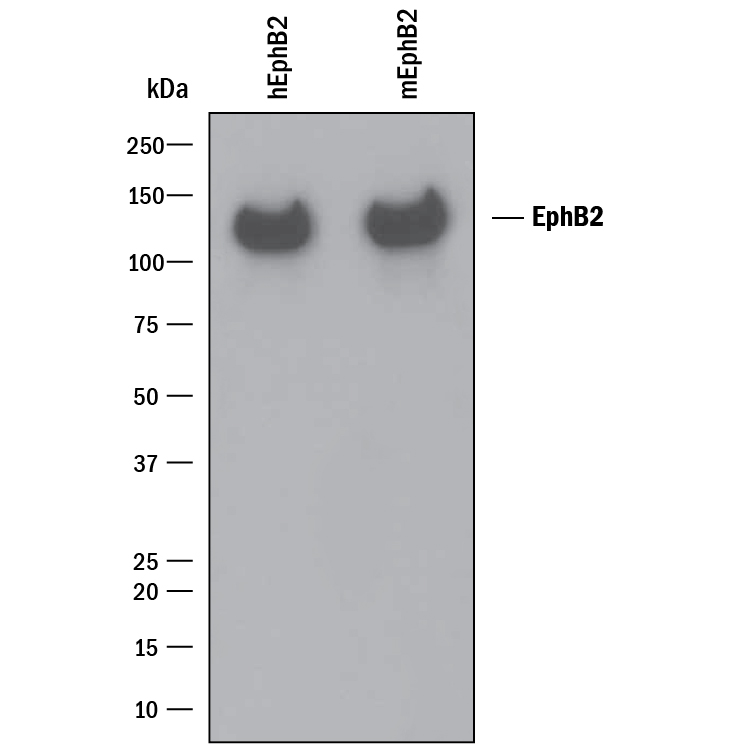 View Larger
View Larger
Detection of Recombinant Human and Mouse EphB2 by Western Blot. Western blot shows 25 ng of Recombinant Human EphB2 Fc Chimera (Catalog # 5189-B2) and Recombinant Mouse EphB2 Fc Chimera (Catalog # 467-B2). PVDF Membrane was probed with 0.1 µg/mL of Goat Anti-Human/Mouse EphB2 Antigen Affinity-purified Polyclonal Antibody (Catalog # AF467) followed by HRP-conjugated Anti-Goat IgG Secondary Antibody (Catalog # HAF109). A specific band was detected for EphB2 at approximately 120 kDa (as indicated). This experiment was conducted under reducing conditions and using Immunoblot Buffer Group 3.
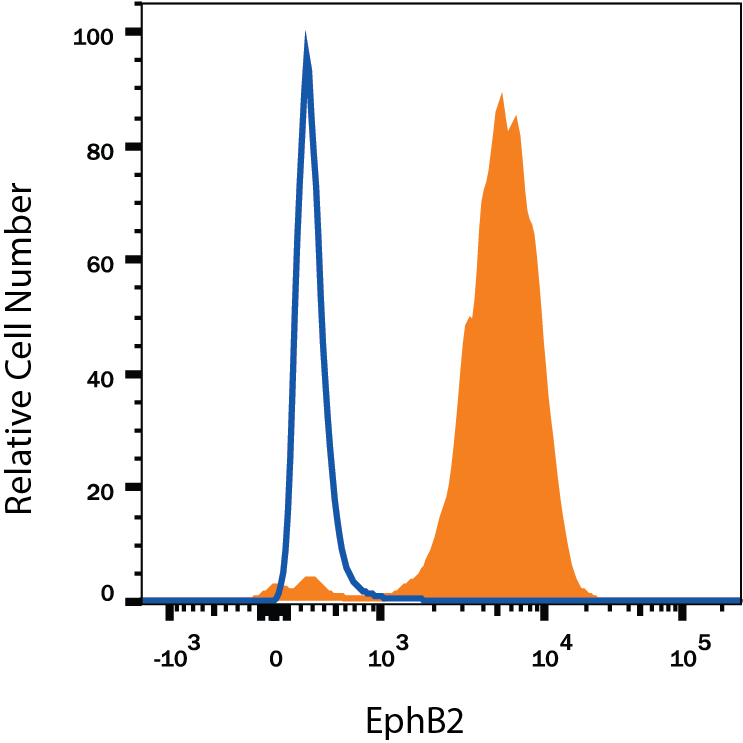 View Larger
View Larger
Detection of EphB2 in COLO 205 Human Cell Line by Flow Cytometry. COLO 205 human colorectal adenocarcinoma cell line was stained with Goat Anti-Human/Mouse EphB2 Antigen Affinity-purified Polyclonal Antibody (Catalog # AF467, filled histogram) or isotype control antibody (Catalog # AB-108-C, open histogram), followed by Phycoerythrin-conjugated Anti-Goat IgG Secondary Antibody (Catalog # F0107). View our protocol for Staining Membrane-associated Proteins.
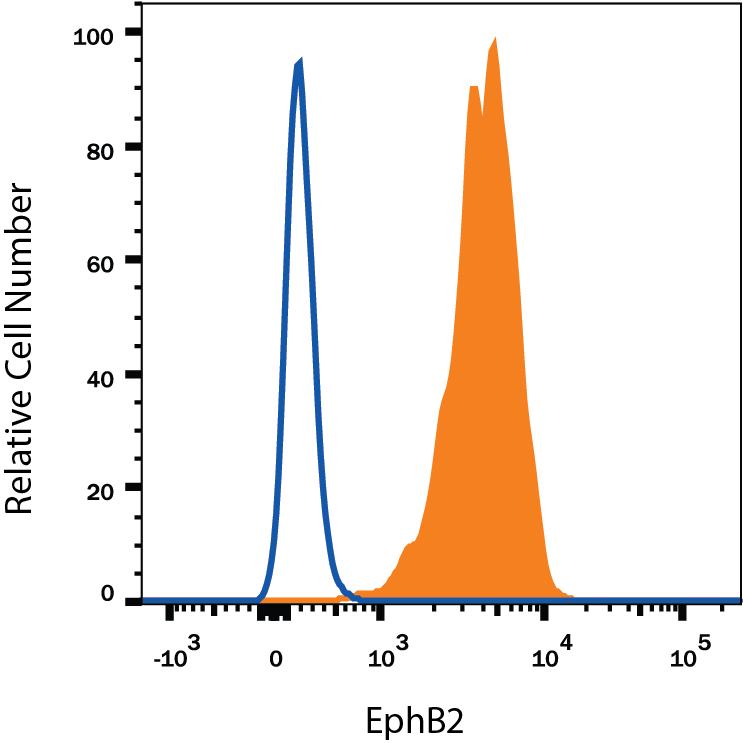 View Larger
View Larger
Detection of EphB2 in D3 Mouse Cell Line by Flow Cytometry. D3 mouse embryonic stem cell line was stained with Goat Anti-Human/Mouse EphB2 Antigen Affinity-purified Polyclonal Antibody (Catalog # AF467, filled histogram) or isotype control antibody (Catalog # AB-108-C, open histogram), followed by Phycoerythrin-conjugated Anti-Goat IgG Secondary Antibody (Catalog # F0107). View our protocol for Staining Membrane-associated Proteins.
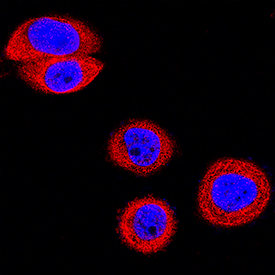 View Larger
View Larger
EphB2 in MBA‑MB‑468 Human Cell Line. EphB2 was detected in immersion fixed MBA-MB-468 human breast cancer cell line using Goat Anti-Human/Mouse EphB2 Antigen Affinity-purified Polyclonal Antibody (Catalog # AF467) at 5 µg/mL for 3 hours at room temperature. Cells were stained using the NorthernLights™ 557-conjugated Anti-Goat IgG Secondary Antibody (red; Catalog # NL001) and counterstained with DAPI (blue). Specific staining was localized to cytoplasm. View our protocol for Fluorescent ICC Staining of Cells on Coverslips.
 View Larger
View Larger
EphB2 in Embryonic Mouse Brain. EphB2 was detected in immersion fixed frozen sections of embryonic mouse brain (15 d.p.c.) using 15 µg/mL Goat Anti-Mouse EphB2 Antigen Affinity-purified Polyclonal Antibody (Catalog # AF467) overnight at 4 °C. Tissue was stained with the NorthernLights™ 557-conjugated Anti-Goat IgG Secondary Antibody (red; Catalog # NL001) and counterstained (green). View our protocol for Fluorescent IHC Staining of Frozen Tissue Sections.
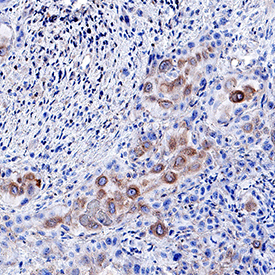 View Larger
View Larger
EphB2 in Human Esophageal Squamous Cell Carcinoma. EphB2 was detected in immersion fixed paraffin-embedded sections of human esophageal squamous cell carcinoma using Goat Anti-Human/Mouse EphB2 Antigen Affinity-purified Polyclonal Antibody (Catalog # AF467) at 3 µg/mL for 1 hour at room temperature followed by incubation with the Anti-Goat IgG VisUCyte™ HRP Polymer Antibody (Catalog # VC004). Tissue was stained using DAB (brown) and counterstained with hematoxylin (blue). Specific staining was localized to cytoplasm in cancer cells. View our protocol for IHC Staining with VisUCyte HRP Polymer Detection Reagents.
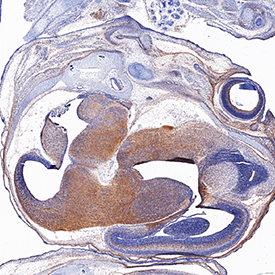 View Larger
View Larger
EphB2 in Mouse Embryo. EphB2 was detected in immersion fixed frozen sections of mouse embryo (13 d.p.c.) using Goat Anti-Human/Mouse EphB2 Antigen Affinity-purified Polyclonal Antibody (Catalog # AF467) at 1.7 µg/mL for 1 hour at room temperature followed by incubation with the Anti-Goat IgG VisUCyte™ HRP Polymer Antibody (Catalog # VC004). Tissue was stained using DAB (brown) and counterstained with hematoxylin (blue). Specific staining was localized to developing brain. View our protocol for IHC Staining with VisUCyte HRP Polymer Detection Reagents.
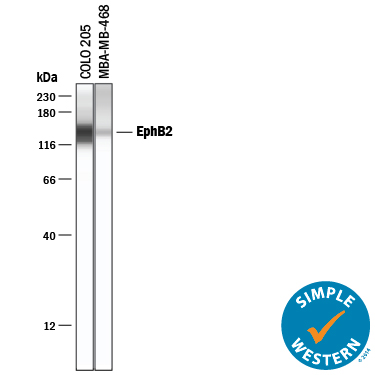 View Larger
View Larger
Detection of Human EphB2 by Simple WesternTM. Simple Western lane view shows lysates of COLO 205 human colorectal adenocarcinoma cell line and MBA-MB-468 human breast cancer cell line, loaded at 0.2 mg/mL. A specific band was detected for EphB2 at approximately 139 and 146 kDa (as indicated) using 20 µg/mL of Goat Anti-Human/Mouse EphB2 Antigen Affinity-purified Polyclonal Antibody (Catalog # AF467) followed by 1:50 dilution of HRP-conjugated Anti-Goat IgG Secondary Antibody (Catalog # HAF109). This experiment was conducted under reducing conditions and using the 12-230 kDa separation system.
Reconstitution Calculator
Preparation and Storage
- 12 months from date of receipt, -20 to -70 °C as supplied.
- 1 month, 2 to 8 °C under sterile conditions after reconstitution.
- 6 months, -20 to -70 °C under sterile conditions after reconstitution.
Background: EphB2
EphB2, also known as Cek5, Nuk, Erk, Qek2, Tyro5, Sek3, Hek5, and Drt (1), is a member of the Eph receptor family which binds members of the ephrin ligand family. There are two classes of receptors, designated A and B. Both the A and B class receptors have an extracellular region consisting of a globular domain, a cysteine-rich domain, and two fibronectin type III domains. This is followed by the transmembrane region and the cytoplasmic region. The cytoplasmic region contains a juxtamembrane motif with two tyrosine residues which are the major autophosphorylation sites, a kinase domain, and a conserved sterile alpha motif (SAM) in the carboxy tail which contains one conserved tyrosine residue. Activation of kinase activity occurs after ligand recognition and binding. EphB2 has been shown to bind ephrin-B1, ephrin-B2, and ephrin-B3 (2, 3). The extracellular domains of human and mouse EphB2 share 99% amino acid identity. Only membrane-bound or
Fc‑clustered ligands are capable of activating the receptor in vitro. Soluble monomeric ligands bind the receptor but do not induce receptor autophosphorylation and activation (2). In vivo, the ligands and receptors display reciprocal expression (3). It has been found that nearly all the receptors and ligands are expressed in developing and adult neural tissue (3). The ephrin/Eph families also appear to play a role in angiogenesis (3).
- Eph Nomenclature Committee [letter] (1997) Cell 90:403.
- Flanagan, J.G. and P. Vanderhaeghen (1998) Annu. Rev. Neurosci. 21:309.
- Pasquale, E.B. (1997) Curr. Opin. Cell Biol. 9:608.
Product Datasheets
Citations for Human/Mouse EphB2 Antibody
R&D Systems personnel manually curate a database that contains references using R&D Systems products. The data collected includes not only links to publications in PubMed, but also provides information about sample types, species, and experimental conditions.
43
Citations: Showing 1 - 10
Filter your results:
Filter by:
-
Image-based profiling and deep learning reveal morphological heterogeneity of colorectal cancer organoids
Authors: Huang, K;Li, M;Li, Q;Chen, Z;Zhang, Y;Gu, Z;
Computers in biology and medicine
Species: Human hepegivirus
Sample Types: Organoid
Applications: Immunohistochemistry -
Ubiquitin ligase and signalling hub MYCBP2 is required for efficient EPHB2 tyrosine kinase receptor function
Authors: Chang, C;Banerjee, SL;Park, SS;Zhang, X;Cotnoir-White, D;Desbois, M;Grill, B;Kania, A;
bioRxiv : the preprint server for biology
Species: Rat, Human
Sample Types: Cell Lysates
Applications: Western Blot -
Role of EphB2/ephrin-B1 signalling in the development and progression of obesity-associated colorectal cancer
Authors: Y Suzuki, K Okabayashi, H Hasegawa, M Tsuruta, R Seishima, T Tokuda, Y Kitagawa
Oncology Letters, 2022-07-19;24(3):316.
Species: Human
Sample Types: Whole Tissue
Applications: IHC -
EPH receptor tyrosine kinases phosphorylate the PAR-3 scaffold protein to modulate downstream signaling networks
Authors: SL Banerjee, F Lessard, FJM Chartier, K Jacquet, AI Osornio-He, V Teyssier, K Ghani, N Lavoie, JN Lavoie, M Caruso, P Laprise, S Elowe, JP Lambert, N Bisson
Cell Reports, 2022-07-05;40(1):111031.
Species: Human
Sample Types: Cell Lysates
Applications: Western Blot -
Tracheal separation is driven by NKX2-1-mediated repression of Efnb2 and regulation of endodermal cell sorting
Authors: AE Lewis, A Kuwahara, J Franzosi, JO Bush
Cell Reports, 2022-03-15;38(11):110510.
Species: Mouse
Sample Types: Whole Tissue
Applications: IF -
Accumulation of Paneth Cells in Early Colorectal Adenomas Is Associated with Beta-Catenin Signaling and Poor Patient Prognosis
Authors: E López-Arri, B Yan, T Lobo-Jarne, Y Guillén, S Menéndez, M Andreu, A Bigas, M Iglesias, L Espinosa
Cells, 2021-10-28;10(11):.
Species: Human
Sample Types: Whole Tissue
Applications: IHC -
Tyrosine phosphorylation of DEPTOR functions as a molecular switch to activate mTOR signaling
Authors: L M Gagné, N Morin, N Lavoie, N Bisson, JP Lambert, FA Mallette, MÉ Huot
The Journal of Biological Chemistry, 2021-10-09;297(5):101291.
Species: Human
Sample Types: Cell Lysates
Applications: Western Blot -
Identification of tetracycline combinations as EphB1 tyrosine kinase inhibitors for treatment of neuropathic pain
Authors: MS Ahmed, P Wang, NUN Nguyen, Y Nakada, I Menendez-M, M Ismail, R Bachoo, M Henkemeyer, HA Sadek, ES Kandil
Proceedings of the National Academy of Sciences of the United States of America, 2021-03-09;118(10):.
Species: Mouse
Sample Types: Tissue Homogenates
Applications: Western Blot -
Ephrin-B2 paces neuronal production in the developing neocortex
Authors: A Kischel, C Audouard, MA Fawal, A Davy
BMC Dev. Biol., 2020-05-13;20(1):12.
Species: Mouse
Sample Types: In Vivo
Applications: In Vivo -
Atypical chemokine receptor ACKR3/CXCR7 controls postnatal vasculogenesis and arterial specification by mesenchymal stem cells via Notch signaling
Authors: ST Wei, YC Huang, ML Hsieh, YJ Lin, WC Shyu, HC Chen, CH Hsieh
Cell Death Dis, 2020-05-04;11(5):307.
Species: Human
Sample Types: Cell Culture Supernates
Applications: Western Blot -
EPH receptor B2 stimulates human monocyte adhesion and migration independently of its EphrinB ligands
Authors: D Vreeken, CS Bruikman, SML Cox, H Zhang, R Lalai, A Koudijs, AJ van Zonnev, GK Hovingh, JM van Gils
J. Leukoc. Biol., 2020-04-26;0(0):.
Species: Human
Sample Types: Whole Tissue
Applications: IHC -
Generation of intestinal organoids derived from human pluripotent stem cells for drug testing
Authors: S Yoshida, H Miwa, T Kawachi, S Kume, K Takahashi
Sci Rep, 2020-04-06;10(1):5989.
Species: Human
Sample Types: Whole Cells
Applications: ICC -
Positive surface charge of GluN1 N-terminus mediates the direct interaction with EphB2 and NMDAR mobility
Authors: HR Washburn, NL Xia, W Zhou, YT Mao, MB Dalva
Nat Commun, 2020-01-29;11(1):570.
Species: Mouse
Sample Types: Whole Cells
Applications: Functional Assay, ICC -
CD74 signaling links inflammation to intestinal epithelial cell regeneration and promotes mucosal healing
Authors: L Farr, S Ghosh, N Jiang, K Watanabe, M Parlak, R Bucala, S Moonah
Cell Mol Gastroenterol Hepatol, 2020-01-28;0(0):.
Species: Mouse
Sample Types: Whole Tissue
Applications: IHC -
Spatial EGFR Dynamics and Metastatic Phenotypes Modulated by Upregulated EphB2 and Src Pathways in Advanced Prostate Cancer
Authors: YL Liu, AM Horning, B Lieberman, M Kim, CK Lin, CN Hung, CW Chou, CM Wang, CL Lin, NB Kirma, MA Liss, R Vasisht, EP Perillo, K Blocher, H Horng, JA Taverna, J Ruan, TE Yankeelov, AK Dunn, TH Huang, HC Yeh, CL Chen
Cancers (Basel), 2019-12-01;11(12):.
Species: Human
Sample Types: Cell Lysates
Applications: Western Blot -
The Schizophrenia Susceptibility Gene OPCML Regulates Spine Maturation and Cognitive Behaviors through Eph-Cofilin Signaling
Authors: Z Zhang, M Ye, Q Li, Y You, H Yu, Y Ma, L Mei, X Sun, L Wang, W Yue, R Li, J Li, D Zhang
Cell Rep, 2019-10-01;29(1):49-61.e7.
Species: Mouse
Sample Types: Cell Lysates
Applications: Immunoprecipitation, Western Blot -
EphB2-dependent signaling promotes neuronal excitotoxicity and inflammation in the acute phase of ischemic stroke
Authors: AS Ernst, LI Böhler, AM Hagenston, A Hoffmann, S Heiland, C Sticht, M Bendszus, M Hecker, H Bading, HH Marti, T Korff, R Kunze
Acta Neuropathol Commun, 2019-02-05;7(1):15.
Species: Mouse
Sample Types: Tissue Homogenates
Applications: Simple Western -
EphB2 receptor tyrosine kinase promotes hepatic fibrogenesis in mice via activation of hepatic stellate cells
Authors: PN Mimche, CM Lee, SM Mimche, M Thapa, A Grakoui, M Henkemeyer, TJ Lamb
Sci Rep, 2018-02-07;8(1):2532.
Species: Mouse
Sample Types: Whole Cells, Whole Tissue
Applications: ICC, IHC-P -
Generation of Mouse and Human Organoid-Forming Intestinal Progenitor Cells by Direct Lineage Reprogramming
Authors: S Miura, A Suzuki
Cell Stem Cell, 2017-09-21;0(0):.
Species: Mouse
Sample Types: Whole Tissue
Applications: IHC -
Ascl1 promotes tangential migration and confines migratory routes by induction of Ephb2 in the telencephalon
Authors: YH Liu, JW Tsai, JL Chen, WS Yang, PC Chang, PL Cheng, DL Turner, Y Yanagawa, TW Wang, JY Yu
Sci Rep, 2017-03-09;7(0):42895.
Species: Mouse
Sample Types: Whole Cells, Whole Tissue
Applications: ICC, IHC-Fr -
Lipid-mediated Wnt protein stabilization enables serum-free culture of human organ stem cells
Authors: N Tüysüz, L van Bloois, S van den Br, H Begthel, MM Verstegen, LJ Cruz, L Hui, LJ van der La, J de Jonge, R Vries, E Braakman, E Mastrobatt, JJ Cornelisse, H Clevers, D Ten Berge
Nat Commun, 2017-03-06;8(0):14578.
Species: Human
Sample Types: Whole Tissue
Applications: IHC -
Blocking the Interaction between EphB2 and ADDLs by a Small Peptide Rescues Impaired Synaptic Plasticity and Memory Deficits in a Mouse Model of Alzheimer's Disease
Authors: Can Gao
J. Neurosci., 2016-11-23;36(47):11959-11973.
Species: Rat
Sample Types: Protein, Whole Cells
Applications: ICC, Western Blot -
Induction of endoplasmic reticulum stress by deletion of Grp78 depletes Apc mutant intestinal epithelial stem cells
Oncogene, 2016-11-07;0(0):.
Species: Mouse
Sample Types: Whole Tissue
Applications: IHC-P -
Unidirectional Eph/ephrin signaling creates a cortical actomyosin differential to drive cell segregation
Authors: AK O'Neill, AA Kindberg, TK Niethamer, AR Larson, HH Ho, ME Greenberg, JO Bush
J. Cell Biol., 2016-10-17;215(2):217-229.
Species: Mouse
Sample Types: Whole Tissue
Applications: IHC -
The transcription factor XBP1s restores hippocampal synaptic plasticity and memory by control of the Kalirin-7 pathway in Alzheimer model
Mol Psychiatry, 2016-09-20;0(0):.
Species: Mouse
Sample Types: Whole Tissue
Applications: IHC-Fr -
EphrinB2 repression through ZEB2 mediates tumour invasion and anti-angiogenic resistance
Nat Commun, 2016-07-29;7(0):12329.
Species: Mouse
Sample Types: Tissue Homogenates
Applications: Western Blot -
Tissue-Specific Effects of Reduced beta-catenin Expression on Adenomatous Polyposis Coli Mutation-Instigated Tumorigenesis in Mouse Colon and Ovarian Epithelium.
Authors: Feng Y, Sakamoto N, Wu R, Liu J, Wiese A, Green M, Green M, Akyol A, Roy B, Zhai Y, Cho K, Fearon E
PLoS Genet, 2015-11-03;11(11):e1005638.
Species: Mouse
Sample Types: Whole Tissue
Applications: IHC-P -
GluA2 trafficking is involved in apoptosis of retinal ganglion cells induced by activation of EphB/EphrinB reverse signaling in a rat chronic ocular hypertension model.
Authors: Dong L, Gao F, Wang X, Miao Y, Wang S, Wu Y, Li F, Wu J, Cheng X, Sun X, Yang X, Wang Z
J Neurosci, 2015-04-01;35(13):5409-21.
Species: Rat
Sample Types: Tissue Homogenates, Whole Tissue
Applications: IHC, Western Blot -
A mathematical model for eph/ephrin-directed segregation of intermingled cells.
Authors: Aharon, Rotem, Janes, Peter W, Burgess, Anthony, Hamza, Kais, Klebaner, Fima, Lackmann, Martin
PLoS ONE, 2014-12-01;9(12):e111803.
Species: Human
Sample Types: Cell Lysates
Applications: Western Blot -
Instruction of circulating endothelial progenitors in vitro towards specialized blood-brain barrier and arterial phenotypes.
Authors: Boyer-Di Ponio J, El-Ayoubi F, Glacial F, Ganeshamoorthy K, Driancourt C, Godet M, Perriere N, Guillevic O, Couraud P, Uzan G
PLoS ONE, 2014-01-02;9(1):e84179.
Species: Human
Sample Types: Whole Cells
Applications: ICC -
Reelin induces EphB activation.
Authors: Bouche E, Romero-Ortega M, Henkemeyer M, Catchpole T, Leemhuis J, Frotscher M, May P, Herz J, Bock H
Cell Res, 2013-01-15;23(4):473-90.
Species: Mouse
Sample Types: Cell Lysates, Whole Cells
Applications: ICC, Western Blot -
Neuropsin cleaves EphB2 in the amygdala to control anxiety.
Authors: Attwood BK, Bourgognon JM, Patel S, Mucha M, Schiavon E, Skrzypiec AE, Young KW, Shiosaka S, Korostynski M, Piechota M, Przewlocki R, Pawlak R
Nature, 2011-04-20;473(7347):372-5.
Species: Mouse
Sample Types: In Vivo, Tissue Homogenates, Whole Cells, Whole Tissue
Applications: IHC-Fr, Immunoprecipitation, Neutralization, Western Blot -
Smad3 contributes to positioning of proliferating cells in colonic crypts by inducing EphB receptor protein expression.
Authors: Furukawa K, Sato T, Katsuno T, Nakagawa T, Noguchi Y, Tokumasa A, Yokote K, Yokosuka O, Saito Y
Biochem. Biophys. Res. Commun., 2011-01-26;405(4):521-6.
Species: Mouse
Sample Types: Cell Lysates, Whole Tissue
Applications: IHC-P, Western Blot -
Ephrin-B1 regulates axon guidance by reverse signaling through a PDZ-dependent mechanism.
Authors: Bush JO, Soriano P
Genes Dev., 2009-06-10;23(13):1586-99.
Species: Mouse
Sample Types: Tissue Homogenates, Whole Tissue
Applications: IHC-Fr, Immunoprecipitation, Western Blot -
EphrinB2 regulation by PTH and PTHrP revealed by molecular profiling in differentiating osteoblasts.
Authors: Allan EH, Hausler KD, Wei T, Gooi JH, Quinn JM, Crimeen-Irwin B, Pompolo S, Sims NA, Gillespie MT, Onyia JE, Martin TJ
J. Bone Miner. Res., 2008-08-01;23(8):1170-81.
Species: Mouse
Sample Types: Cell Lysates
Applications: Western Blot -
Ephrin-B reverse signaling promotes structural and functional synaptic maturation in vivo.
Authors: Lim BK, Matsuda N, Poo MM
Nat. Neurosci., 2008-01-13;11(2):160-9.
Species: Xenopus
Sample Types: Tissue Homogenates
Applications: Immunoprecipitation -
Phosphorylation of ephrin-B1 regulates dissemination of gastric scirrhous carcinoma.
Authors: Tanaka M, Kamata R, Takigahira M, Yanagihara K, Sakai R
Am. J. Pathol., 2007-07-01;171(1):68-78.
Species: Mouse
Sample Types: Whole Cells
Applications: Western Blot -
Fish oil increases cholesterol storage in white adipose tissue with concomitant decreases in inflammation, hepatic steatosis, and atherosclerosis in mice.
Authors: Saraswathi V, Gao L, Morrow JD, Chait A, Niswender KD, Hasty AH
J. Nutr., 2007-07-01;137(7):1776-82.
Species: Human
Sample Types: Whole Tissue
Applications: IHC-P -
Cupredoxin-cancer interrelationship: azurin binding with EphB2, interference in EphB2 tyrosine phosphorylation, and inhibition of cancer growth.
Authors: Chaudhari A, Mahfouz M, Fialho AM, Yamada T, Granja AT, Zhu Y, Hashimoto W, Schlarb-Ridley B, Cho W, Das Gupta TK, Chakrabarty AM
Biochemistry, 2007-01-24;46(7):1799-810.
Species: Human
Sample Types: Cell Lysates
Applications: Immunoprecipitation -
EphB receptors coordinate migration and proliferation in the intestinal stem cell niche.
Authors: Holmberg J, Genander M, Halford MM, Anneren C, Sondell M, Chumley MJ, Silvany RE, Henkemeyer M, Frisen J
Cell, 2006-06-16;125(6):1151-63.
Species: Mouse
Sample Types: Tissue Homogenates, Whole Tissue
Applications: IHC, Immunoprecipitation -
EphB2 and ephrin-B1 expressed in the adult kidney regulate the cytoarchitecture of medullary tubule cells through Rho family GTPases.
Authors: Ogawa K, Wada H, Okada N, Harada I, Nakajima T, Pasquale EB, Tsuyama S
J. Cell. Sci., 2006-02-01;119(0):559-70.
Species: Mouse
Sample Types: Whole Tissue
Applications: IHC -
EphB2/R-Ras signaling regulates glioma cell adhesion, growth, and invasion.
Authors: Nakada M, Niska JA, Tran NL, McDonough WS, Berens ME
Am. J. Pathol., 2005-08-01;167(2):565-76.
Species: Human
Sample Types: Cell Lysates, Tissue Homogenates, Whole Cells, Whole Tissue
Applications: ICC, IHC-P, Immunoprecipitation, Western Blot -
The phosphorylation of EphB2 receptor regulates migration and invasion of human glioma cells.
Authors: Nakada M, Niska JA, Miyamori H, McDonough WS, Wu J, Sato H, Berens ME
Cancer Res., 2004-05-01;64(9):3179-85.
Species: Human
Sample Types: Cell Lysates, Whole Cells
Applications: ICC, Immunoprecipitation, Neutralization, Western Blot
FAQs
No product specific FAQs exist for this product, however you may
View all Antibody FAQsReviews for Human/Mouse EphB2 Antibody
Average Rating: 4.5 (Based on 4 Reviews)
Have you used Human/Mouse EphB2 Antibody?
Submit a review and receive an Amazon gift card.
$25/€18/£15/$25CAN/¥75 Yuan/¥2500 Yen for a review with an image
$10/€7/£6/$10 CAD/¥70 Yuan/¥1110 Yen for a review without an image
Filter by:




